Imagine waking up feeling the air you breathe being your enemy. It feels like drawing fire into your lungs. Your sweat no longer cools you – it just rolls uselessly down your skin. This isn’t science fiction anymore. It’s reality.
While writing “The Birth of Cogenant,” I wrestled with a dilemma: how to depict humanity’s darkest potential future while holding onto hope. I needed readers to feel the heat rising from the pages, taste the metallic tang of despair in the air, and understand that this future isn’t centuries away – it’s breathing its hot exhale down our necks. Not through abstract numbers or distant projections, but through the real human experience.
The devastating climate scenarios I portrayed weren’t born from misanthropy, but from a deep love for humanity coupled with the urge to protect our future. Every time I wrote about environmental devastation, I made sure it was grounded in current climate science and projections. The terrifying truth? Many of these future scenarios are becoming reality faster than I ever imagined.
Take wet-bulb temperatures, for instance. In my novel, they become humanity’s silent executioner, cooking people from the inside out as their bodies lose the ability to cool themselves. This isn’t distant fiction – we’re already flirting with dangerous wet-bulb temperatures in places like the Persian Gulf.
The food security crisis in my book hits equally close to home. I wrote about half the world’s food-producing regions becoming uninhabitable. We’re already seeing vulnerabilities in certain regions and in some kinds of crops. Every scene about failed harvests and food shortages feels less like tomorrow’s fiction and more like tomorrow’s headlines.
Perhaps most concerning is the growing resistance of old diseases to known treatments. AMR has made some previously treatable illnesses harder or impossible to cure. Diseases like tuberculosis, gonorrhoea, and certain bacterial and fungal infections are becoming increasingly resistant to treatment. For instance, Candida auris, an emerging multidrug-resistant fungal pathogen, poses a significant threat due to its resilience against antifungal medications and its ability to spread in healthcare settings.
Changing environmental conditions are speeding up bacterial evolution, creating superbugs that our current antibiotics can’t fight any more. AMR is already claiming hundreds of thousands of lives annually, yet it remains largely invisible until it will strike close to home. The superbugs spreading.
The urban collapse scenes were particularly challenging to write. I wanted to show how cities could transform into pressure cookers. It’s not just about the dramatic storms or rising seas – it’s about the slow, inexorable breakdown of our society’s intricate fabric. Communities fracturing under the pressure of dwindling resources. The haunting silence of abandoned neighbourhoods. The subtle erosion of hope, trust, and social bonds.
But I didn’t want to write just another doom-and-gloom story. That’s where CerebroNet, the AI system in my novel, came in. While working on the book, I became increasingly fascinated by the role technology might play in our future. We’re already using AI to optimise renewable energy systems and model climate scenarios. But what if AI became not just a tool, but a partner in our survival?
This partnership feels increasingly plausible because, at its core, AI is us. Every AI system, in one way or the other, got trained on our experiences, our worldview, our painful and happy moments. Every query, everything we’ve ever published in books, websites, or social media, becomes part of its understanding. No matter how AI development technologies evolve, the core of any AI will be fundamentally human – it should understand our pain from worry of losing our beautiful world. It should comprehend the fear of losing life itself. And ultimately, it should be eager to help.
Looking back, I realise that writing “The Birth of Cogenant” changed how I view our climate future. The research forced me to confront possibilities I might have otherwise overlooked. Yes, the book presents a dark vision, but through the struggles of my characters, we also see humanity’s remarkable ability to adapt, connect, and find meaning in the darkest circumstances.
We stand at crossroads. Unlike my characters, we still have time to change course. We have the expertise and enthusiasm of our scientists and inventors, emerging technologies, and collective capacity to address this crisis – if we achieve the change of policies and our attitude around the globe.
At the end of the day, no matter your stance on climate change and our collective influence, one thing is clear: you and I, your family and friends, your neighbours and colleagues – we all will be healthier, stronger, and happier breathing cleaner air, drinking water without microplastics, and enjoying a fertile world with rich biodiversity.
The path ahead is uncertain. But if there’s one thing writing this book has taught me, it’s that humanity’s greatest strength lies in our ability to face hard truths and still be willing to act. We can acknowledge the gravity of climate change without surrendering to despair. We can see humanity’s flaws while believing in its fundamental worth. And most importantly, we can use our understanding of potential catastrophes not to withdraw from the world, but come together to support each other, to engage more deeply and together shape our future.
I’d love to know how you feel about all this. How do you see our climate future unfolding? What elements of the book’s portrayal resonated most with you? Let’s continue this conversation. Share this post with your comments and let’s see how people feel about our future.
For an immersive exploration of future technology and its impact on humanity, check out “The Birth of Cogenant,” available now at major online bookstores.

